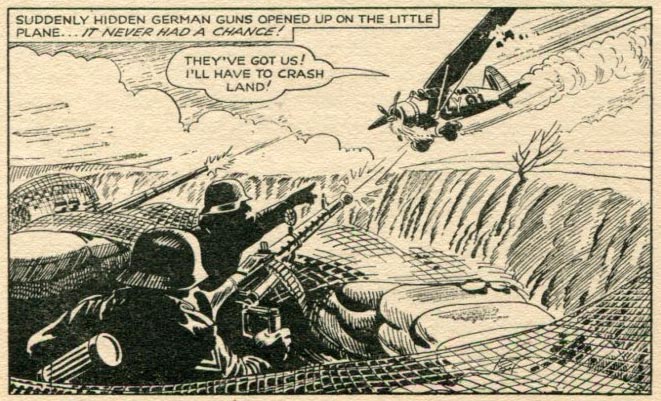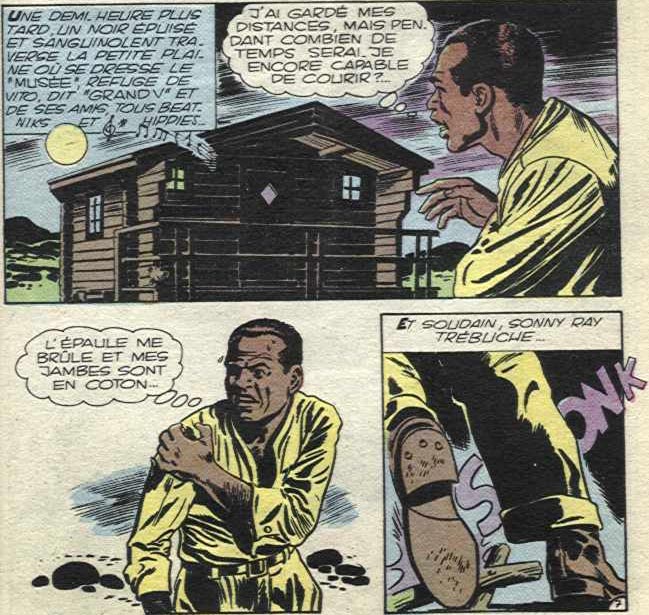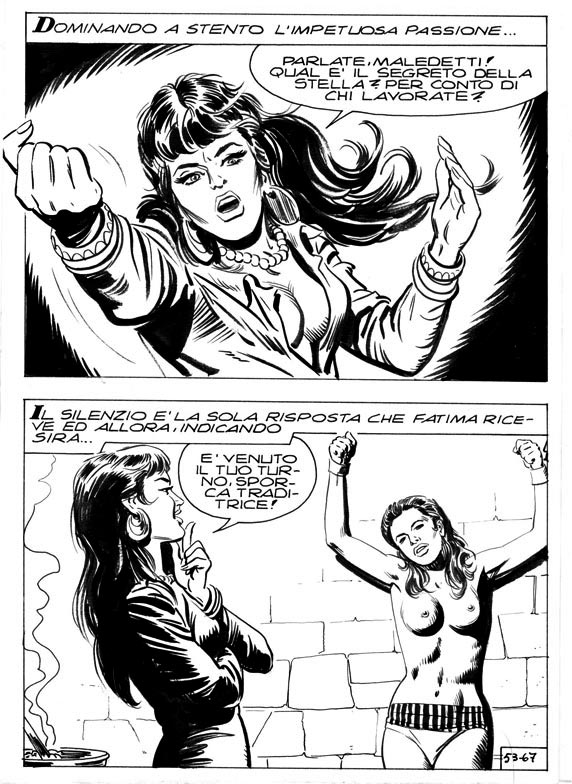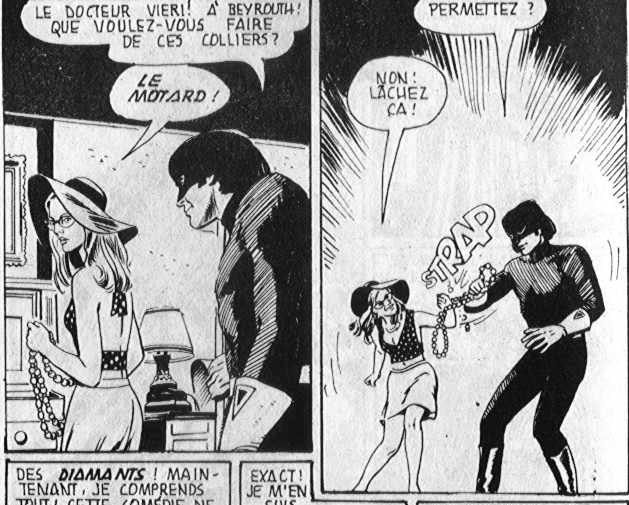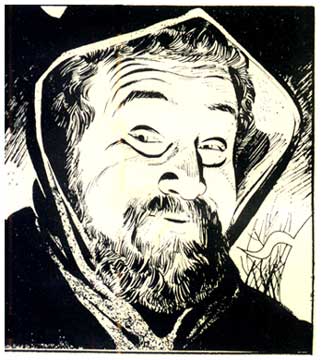Martin Mystere #87 'L'Uomo Delle Nevi'.
Sergio Tuis was an Italian comic book artist and painter, whose career spanned from the mid-1950s through the early 2010s. In his home country, he was known for drawing comic book series like 'La Pattuglia dei Bufali' (1957), 'Kirby Flint' (1971-1973) and 'Agente senza Nome' (1972-1975), before becoming a regular artist on Bonelli's 'Martin Mystère' in the 1980s. He was furthermore one of many Italian agency artists working on stories for UK war comics ('Battler Britton') and French pocket books ('Guillaume Tell', 'Les Anges de l'Enfer').
Early life
Sergio Tuis was born in 1935 in San Donà di Piave, which is part of the Metropolitan City of Venice, during a visit of his mother to her home country. The Tuis family actually lived 18 kilometers north of Paris, in the French town Domont, where young Sergio spent the first years of his life. His father, a hobby sculptor, took both Sergio and his brother Aldo to the Louvre to encourage his sons with a passion for the Italian masters. The family returned to Tuis' birth town in Italy shortly after the Nazis had invaded Paris. They were forced to retreat to a nearby village because of frequent Anglo-American bombardments. It was during these eventful years that young Sergio Tuis discovered the adventure novels of Emilio Salgari. He picked up drawing, and made paintings depicting the Piave river.
Education and early career
From 1952 onwards Tuis attended the School of Applied Arts of Castello Sforzesco in Milan, while also taking courses in drawing nudes in Brera. He was completely devoted to painting, visited all the local galleries, read the leading art magazines, and won several prizes during his university years. To make a living, he began to draw comics through Rinaldo Dami's Studio Creazioni D'Ami in 1956, which was located in the Torre Velasca skyscraper. The agency provided comic book artwork for local publishers like Casa Audace Editrice, the predecessor of the current Sergio Bonelli Editore, but also for publishers in the UK, France and Germany. One of Tuis' first assignments was drawing issues of Audace's landscape format-shaped western comic book 'La Pattuglia dei Bufali' (literally: "The Buffalo Patrol", 1957). It starred the former cavalry officer Dix Leroy, who came up for the well-being of Indians and buffaloes in the western plains. Other notable artists for the series were D'Ami alumni like Giovanni Ticci and Renzo Calegari. It appeared under the title 'La Patrouille des Bisons' in the French comic book Mustang by Lug. In the 1960s Tuis served as a cover artist for the western comic book 'Pecos Bill' by Edizione Angelo Fasani.
Battler Britton - 'Treachery in the Desert'.
Work for Britain
Tuis was also assigned to Dami's international productions. For the British publisher Amalgamated Press, he illustrated many episodes about World War II Spitfire pilot 'Battler Britton'. These appeared on the front cover of The Sun (late 1950s) and Knock-Out (1960-1961), and later in war anthology titles like the Thriller Picture Library, Air Ace Picture Library and War Picture Library. Some of these comics were made in collaboration with Aldo Di Gennaro. Tuis furthermore worked for Dami's production of the British western comic 'Kit Carson', and on independent war stories in aforementioned anthologies.
'Les Anges de l'Enfer'.
Work for France
He was a pencil artist of 'Le Condor du Désert' (1958), a western series published in the French pocket comic book Dakota by Éditions Aventures et Voyages. After ending his association with Dami in 1963, he continued to work for French pocket comic books through the Agenzia Martini-Maffi, a Milanese agency headed by Leonello Martini and Arnalda Maffi. For the Lyon-based publisher Lug, he provided artwork to 'Sadko, le Prince-Archer' (1964) in Rodéo, the medieval feature about the legendary William Tell ('Guillaume Tell', 1965-1967) in Zembla and the adventure comic 'Slim' (1968) in Ombrax. Another Lug production was a feature about dragsters, called 'Les Anges de l'Enfer' (literally: "Hell's Angels"), which ran in Kiwi (1969) and Ombrax (1974-1977). In the 1980s, both 'Guillaume Tell' (1984-1986) and 'Les Anges de l'Enfer' (1987-1990) reappeared, this time in the comic book Blek.
'Helga' #53.
Pulp comics
In Italy, Tuis was one of several artists providing artwork to the humorous superhero comic 'Kolosso' (1964-1966), an ironical parody of the Sword and Sandal film genre created by Carlo Porciani and Mario Faustinelli for Casa Editrice Gli Amici. Under the pen name Twist, he drew an erotic science-fantasy comic called 'Imperatrix 3000' (1969), which appeared in both Lionello Bianchi's short-lived news monthly Personal and Renato Giuntini's adult monthly Essere. Between 1969 and 1971 he illustrated eight issues of 'Helga, l'Amazzone della Guerra' for Furio Viano Editore. The series, created by Luigi Naviglio and Ingam, was part of Italy's wave of erotic pulp comic books and starred an extremely scantily dressed amazon fighter in contemporary war settings. Around the same period, Tuis contributed to Horror, the anthology comic book by Pier Carpi and Alfredo Castelli which tried to mimic the US titles Eerie and Creepy. Later that decade, Sergio Tuis would also lend his talents to Edifumetto's adult horror title Lo Scheletro.
'Le Motard' ('Agente senza Nome').
Kirby Flint
One of Tuis' longer series of the 1970s was the Far West hero 'Kirby Flint' (1971-1973). It appeared in the Collana Eldorado collection of Editoriale Dardo and was made in cooperation with fellow artist Antonio Canale. The feature appeared in France in Pistes Sauvages, another publication by Aventures et Voyages.
Agente senza Nome
By 1971, Sergio Tuis collaborated with with children's magazines Il Corriere dei Piccoli and Il Corriere dei Ragazzi, at first with short stories and then with 'Agente senza Nome' (1972-1975) in the latter. Written by Pier Carpi, 'Agente senza Nome' was the secret identity of Franco Drago, who as a masked vigilante helps his private investigator father solve cases. Despite the pulpy outset, the series tackled serious subjects like the mob and corruption. It was reprinted in France under the title 'Le Motard' in Skaters (1978-1979) and En Piste (1980-1981). In 1971 Tuis furthermore drew the series' 'Ken e Dan' in issues #0 and #1 of LanscioStory.
Painting career
Tuis and his wife moved to Seregno in 1970, where the local art scene gradually drifted the artist away from comics. He associated himself with Luciano Silva's gallery. For a decade he painted and exhibited in Italy and abroad, both personally and in collectives. He participated in numerous painting contests, obtaining the first prize in a fortnight, and winning about 15 national prizes in the subsequent years. Tuis mainly made surreal hyperrealistic paintings, portraying empty clothes in action, as if there were bodies inside, accompanied by realistic faces reduced to masks.
Return to comics (Disney/Bonelli)
In the mid-1980s Sergio Tuis returned to the comics medium with a comic book adaptation of the 1985 Disney film 'Return to Oz', in cooperation with scriptwriter Alfredo Castelli. In the USA it was published in comic book format by Scholastic, while the Italian edition was released by Mondadori. He subsequently made a brief appearance in the comic magazine Il Giornalino (Edizioni San Paolo) and then began a long association with Daim Press/Sergio Bonelli Editore. Between 1986 and 1989 put five supernatural investigations of 'Martin Mystère' on paper, most of which written by Alfredo Castelli. He furthermore drew volume #42 of 'Nick Raider' (1991), while a 'Mister No' drawn by Tuis remained unfinished. In 1989 Tuis furthermore illustrated at least the first issue of 'Segreti di Donne', a series of erotic confessions published by Ediperiodici.
Martin Mystere #58 - 'La Valle Perduta'.
In the year 2000, Sergio Tuis and Alfredo Castelli cooperated on the episodes 'Il Re del Terrore a Trento' and 'Il Re del Terrore a Carpi' in the series about masked criminal 'Diabolik'. Another story, 'Colpo alla RAI', was drawn by Tuis but written by Mario Gomboli and Licia Ferraresi. From 2006 on he returned to Bonelli's 'Martin Mystère', first in 'Martin Mystère Presenta' (#23) and then in the regular series with the episodes 'Meteore' (issue #302, 2009) and 'La fine del Mondo' (issue #324, 2012). It marked Sergio Tuis' final comic book work, and the veteran artist returned to painting.
On 2 March 2019, Sergio Tuis passed away in the Lombardy town Cermenate at the age of 83. Renata Tuis, his wife since 1965, has been active as a comic book writer, while his brother Aldo Tuis (1934-1995) was also a painter.






